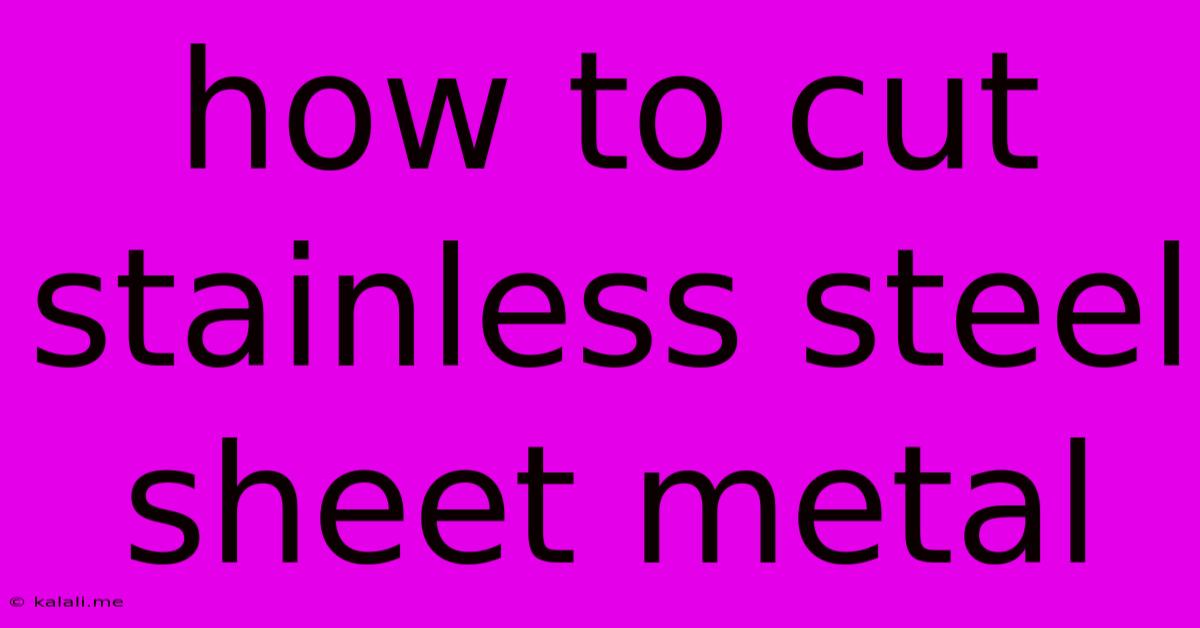How To Cut Stainless Steel Sheet Metal
Kalali
May 23, 2025 · 3 min read

Table of Contents
How to Cut Stainless Steel Sheet Metal: A Comprehensive Guide
Cutting stainless steel sheet metal can seem daunting, but with the right tools and techniques, it's a manageable task for both professionals and DIY enthusiasts. This guide covers various methods, safety precautions, and tips for achieving clean, precise cuts. This will help you whether you're working on a small project or a large-scale fabrication.
Choosing the Right Cutting Method: The best method depends on factors like the thickness of the metal, the desired cut quality, and the available tools.
1. Shearing: For Straight Cuts on Thinner Sheets
Shearing is ideal for straight cuts on thinner stainless steel sheets (typically under 1/8 inch thick). A shearing machine applies a powerful force to cleanly sever the metal. This method produces a relatively burr-free edge. However, it requires specialized equipment and is less versatile for intricate shapes.
2. Slitting: High-Volume, Straight Cuts
For high-volume production of straight cuts in thinner gauges, slitting is a highly efficient method. Slitting machines use rotating blades to cut the metal continuously, offering high speed and accuracy.
3. Plasma Cutting: Versatile Solution for Various Thicknesses
Plasma cutting uses a high-velocity jet of plasma to melt and vaporize the metal. It's exceptionally versatile, handling various thicknesses and producing clean cuts. This method is suitable for both straight and intricate cuts, making it a popular choice for many projects. You'll need a plasma cutter and the appropriate shielding gas.
4. Laser Cutting: Precision and Intricate Designs
Laser cutting provides the highest precision and allows for intricate designs. A high-powered laser beam melts and vaporizes the metal, creating incredibly accurate and detailed cuts. This method is best suited for thinner gauges and complex geometries. However, it requires specialized and expensive equipment.
5. Waterjet Cutting: Precise Cuts for Thicker Materials
Waterjet cutting uses a high-pressure jet of water mixed with abrasive material to cut through the metal. It offers excellent precision, especially for thicker sheets and intricate shapes. This method minimizes heat-affected zones, making it ideal for materials sensitive to heat distortion. It's also a versatile option for various materials besides stainless steel.
6. Band Saw Cutting: Manual Cutting for Irregular Shapes
A band saw with a metal-cutting blade is suitable for curved cuts and irregular shapes. This method provides good control for manual operation, but it requires patience and skill to achieve clean cuts, especially on thicker material. The final cut might require finishing.
7. Nibbling: Precision Cutting for Intricate Shapes
Nibbling uses a reciprocating punch to remove small amounts of metal at a time, creating precise cuts. This is a highly accurate method suitable for intricate shapes and thinner gauge stainless steel. However, it is a relatively slower process compared to other methods.
Safety Precautions:
- Eye protection: Always wear safety glasses or a face shield to protect your eyes from flying debris.
- Hearing protection: Some cutting methods, like plasma cutting, generate loud noise. Use earplugs or earmuffs.
- Gloves: Wear appropriate work gloves to protect your hands.
- Ventilation: Ensure adequate ventilation to remove fumes and dust generated during cutting.
- Proper clothing: Wear clothing that covers exposed skin.
- Fire safety: Take precautions against fire hazards, especially when using methods that generate sparks or heat.
Tips for Clean Cuts:
- Sharp blades/bits: Use sharp blades or cutting tools for clean cuts and to minimize burrs.
- Proper support: Securely support the stainless steel sheet to prevent vibration and movement during cutting.
- Appropriate speed and feed rate: Follow the manufacturer's recommendations for speed and feed rate to prevent damage to the cutting tool or the metal.
- Post-cutting finishing: De-burring and finishing processes may be necessary to achieve a perfect final result depending on the chosen cutting method.
Choosing the right method for cutting stainless steel sheet metal depends on your specific needs and resources. By understanding the various options and following safety precautions, you can achieve professional-quality results. Remember, practice and patience are key to mastering any metal cutting technique.
Latest Posts
Latest Posts
-
Sql Lookup Key Value For Column
May 23, 2025
-
Ender 3 Pro Media Init Fail
May 23, 2025
-
How Long Between Coats Of Polyurethane
May 23, 2025
-
Stalker Soc Brain Scorcher Door Codes
May 23, 2025
-
How To Recover A File After Rm
May 23, 2025
Related Post
Thank you for visiting our website which covers about How To Cut Stainless Steel Sheet Metal . We hope the information provided has been useful to you. Feel free to contact us if you have any questions or need further assistance. See you next time and don't miss to bookmark.